In spite of many wars and fires, the Prague Castle has grown into a unique architectural complex. It contains the Gothic Saint Vitus Cathedral, a convent, several towers and many palace wings.
Brief History
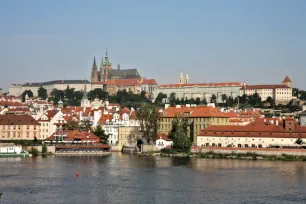
A castle was built at this site as early as in the ninth century. In the twelfth and thirteenth centuries, the castle was fortified and expanded. Around the castle, a small community started to grow. That neighborhood, now called Lesser Town, obtained city rights in 1257.
In the fourteenth century, under the reign of King Charles IV, the whole castle was renovated and expanded. More expansions were built by the House of Habsburg, who also redecorated large parts of the castle in a Baroque and Neoclassical style. After the First World War the castle became the seat of the government of Czechoslovakia and today the president of the Czech Republic still resides here.
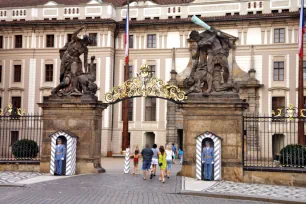
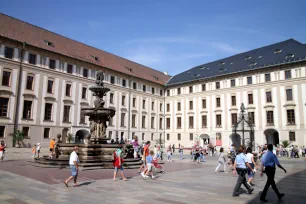
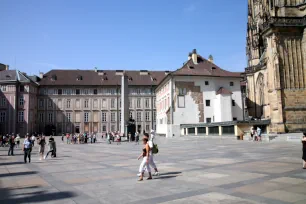
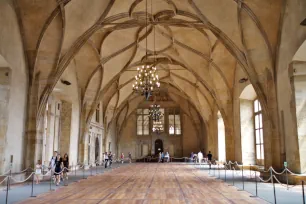
The Courtyards
The castle resembles a small city in the city. There are no less than three courtyards and several streets. An ornate entrance gate at the Castle Square leads to the first courtyard, where on the hour you can watch uniformed palace guards parade during the Change of the Guards.
The entrance gate is decorated with large sculptures of fighting giants and putti, some of which crown a lion and an eagle.
An imposing Baroque portal, the Matthias Gate, connects the small first courtyard to the second courtyard, where you’ll find the Chapel of the Holy Cross and a central fountain. In the palace wing on the left is a museum with a collection of Renaissance and Baroque paintings. An arcade in another wing, which houses offices of the president of the Czech Republic, brings you to the third and largest courtyard, dominated by the St. Vitus Cathedral.
The courtyard is decorated with a replica of a fourteenth century statue of St. George and a 17-meter-tall granite obelisk. The courtyard opens up to the St. George Square, where you’ll find attractions such as the St. George’s Basilica and the Royal Palace. A street leads further to the other end of the castle complex, towards the Lobkowicz Palace and the always crowded Golden Lane.
Royal Palace
After the castle was upgraded to a fortress around 1100 the princes of Bohemia moved into the Royal Palace, also known as the Old Palace. Romanesque and Gothic stories were built on the remains of the first, ninth-century structure. The most remarkable room in the Royal Palace is the majestic Vladislav Hall, built between 1493 and 1502 by Benedict Ried. It is with its great vaulting, which emanates from six pairs of buttresses into a curvilinear ribbing, one of the finest halls of the Middle Ages. The hall is more than 16 meters wide and more than 14 meters high. (52 ft. / 46 ft.)
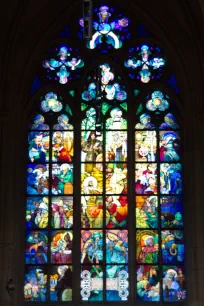
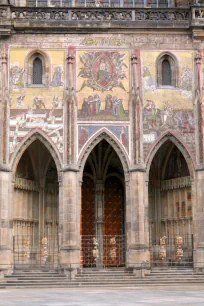

St. Vitus Cathedral
In the center of the Prague Castle is the St. Vitus Cathedral, one of the most recognized landmarks in the city. When Charles IV acquired the bones of St. Vitus – a popular fourth-century martyr – and brought them to Prague, the city became a center of the St. Vitus cult.
In 1344, when Prague became an archbishopric, Charles IV started with the construction of the St. Vitus Cathedral. The first part was built by the Frenchman Mathieu d’Arras. After his death in 1352, Peter Parler took over for the next forty-seven years. In 1421, the Hussite wars stopped work on the cathedral, and it wasn’t until 1872 that works resumed and finally in 1929 the cathedral was completed.
Until the nineteenth century, the Golden Gate (Porta Aurea) was the main gate of St. Vitus. It was used as the doorway by which kings entered on coronation day. Just above the entrance is a large mosaic of the Last Judgment. Inside, the most remarkable part of the church is the surprisingly high chancel with an elegant net vaulting. Also noteworthy is the richly decorated chapel of St. Wenceslas.
St. George’s Basilica and Convent
The basilica of St. George was built in the twelfth century and replaced an older, tenth century church. The façade was added in the seventeenth century. Inside the Romanesque church, you’ll find the graves of Ludmila (860 – 921) – the first Czech Christian martyr – and Duke Vratislav I of Bohemia (915 – 921); his painted wooden grave can be found near the choir.
Adjacent to the basilica is the Convent of St. George, originally built in the tenth century. During the eighteenth century – when the Habsburg emperor Joseph II abolished the monasteries – it was used as a barrack. The building is now home to a museum with a collection of mostly Baroque paintings and statues from the National Gallery, including works from Czech masters such as Petr Brandl and Karel Škréta.
Golden Lane

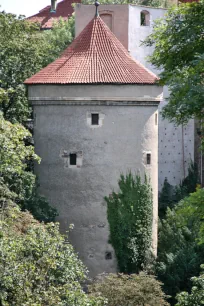
A popular sight at the Prague Castle is the Golden Lane, a small picturesque street with colorful wooden houses. Legend wants one to believe alchemists attempted to turn metal into gold here, but in fact the alchemists lived elsewhere at the castle. It was actually goldsmiths living here in the seventeenth century who gave the street its captivating name.
Towers
Several round towers were built along the walled castle. The most notorious of these is the Daliborka Tower, built in the fifteenth century as part of the fortifications that were constructed during the reign of King Vladislav II the Jagiellonian.
The tower was used as a dungeon and is named after its first inmate, Dalibor of Kozojedy, a Bohemian knight. According to a local legend, he learned to play violin while he was imprisoned and people handed food to him. The grim tower is accessible to visitors and can be reached via the Golden Lane.
Another famous tower is the Powder Tower (not to be confused with the Powder Tower in the Old Town), originally built in 1496 but later rebuilt after it was destroyed by fire in 1541. The tower was the workshop of Tomáš Jaroš, who cast a large bell for the St. Vitus Cathedral while working here. Later, the tower became the workshop of the alchemists, who had convinced emperor Rudolf II that they could turn lead into gold.
There are two other, less illustrious towers at the Prague Castle: the White Tower – facing the Royal Garden – and the Black Tower, guarding the eastern entrance to the castle.

